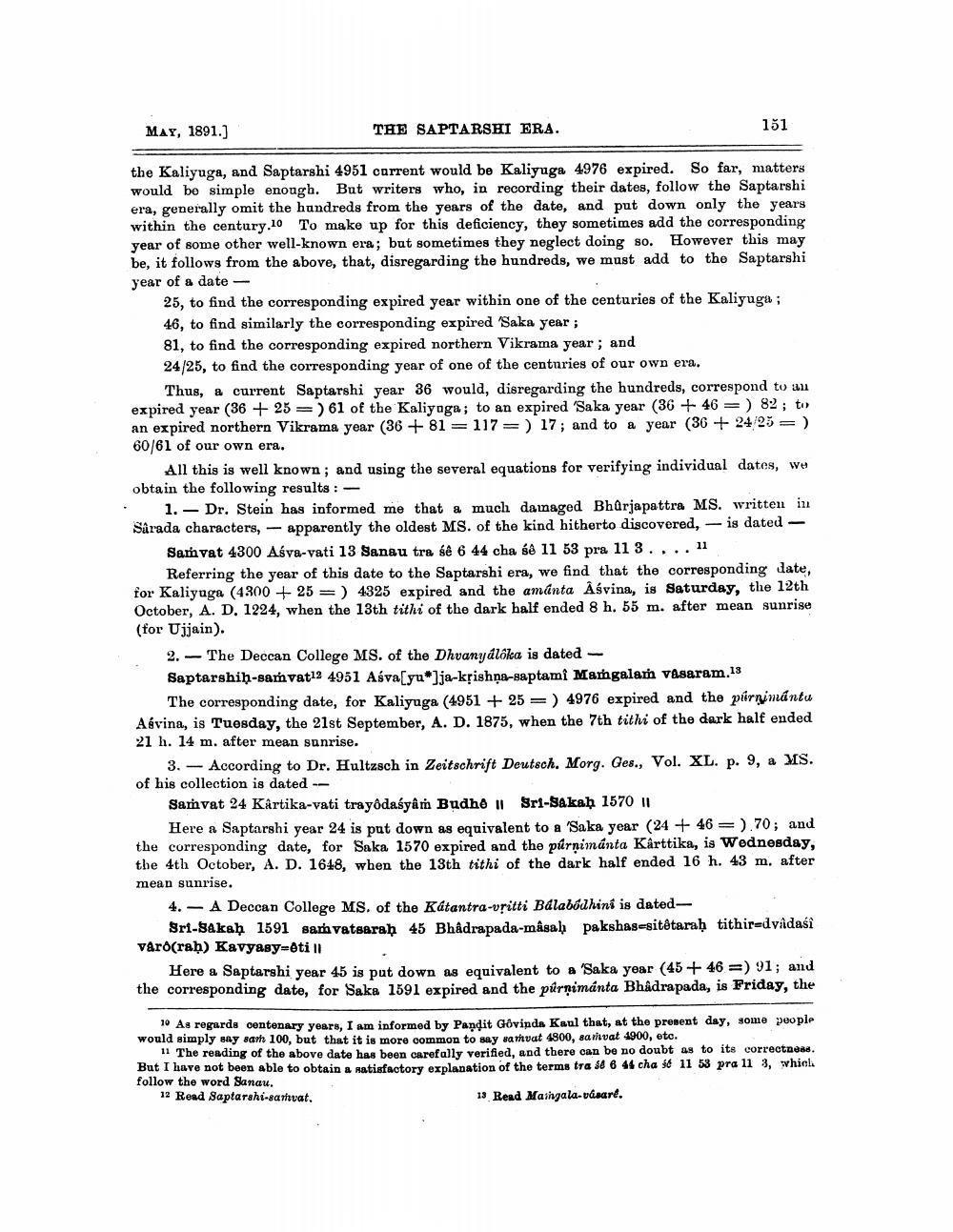________________
MAY, 1891.)
THE SAPTARSHI ERA.
151
the Kaliyuga, and Saptarshi 4951 corrent would be Kaliyuga 4976 expired. So far, matters would be simple enough. But writers who, in recording their dates, follow the Saptarshi era, generally omit the hundreds from the years of the date, and put down only the years within the century.10 To make up for this deficiency, they sometimes add the corresponding year of some other well-known era; but sometimes they neglect doing so. However this may be, it follows from the above, that, disregarding the hundreds, we must add to the Saptarshi year of a date -
25, to find the corresponding expired year within one of the centuries of the Kaliyuga ; 46, to find similarly the corresponding expired 'Saka year; 81, to find the corresponding expired northern Vikrama year; and 24/25, to find the corresponding year of one of the centuries of our own era.
Thus, a current Saptarshi year 36 would, disregarding the hundreds, correspond to an expired year (36 + 25 =) 61 of the Kaliyaga; to an expired 'Saka year (36 + 46=) 82 ; to an expired northern Vikrama year (36 +81=117 =) 17; and to a year (36 + 24 25 =) 60/61 of our own era.
All this is well known; and using the several equations for verifying individual dates, we obtain the following results : -
1.- Dr. Stein has informed me that a much damaged Bharjapattra MS. written in Sûrada characters, - apparently the oldest MS. of the kind hitherto discovered, is dated -
Samvat 4300 Aśva-vati 13 Sanau tra sê 6 44 cha sd 11 53 pra 11 3. ... 11
Referring the year of this date to the Saptarshi era, we find that the corresponding date, for Kaliyuga (4300 + 25 =) 4325 expired and the amánta Āśvina, is Saturday, the 12th October, A. D. 1224, when the 13th tithi of the dark half ended 8 h. 55 m. after mean sunrise (for Ujjain).
2. - The Deccan College MS. of the Dhvanyálôka is dated - Saptarshih-samvat12 4951 Aśvasyu]ja-krishna-saptami Mangalam vasaram.13
The corresponding date, for Kaliyuga (4951 + 25 =) 4976 expired and the párnimántu Akvina, is Tuesday, the 21st September, A. D. 1875, when the 7th tithi of the dark half ended 21 h. 14 m. after mean sunrise.
3. - According to Dr. Hultzsch in Zeitschrift Deutsch. Morg. Ges., Vol. XL. p. 9, a MS. of his collection is dated --
Samvat 24 Kartika-vati trayôdaśyam Budho | Sri-Sakaḥ 1570 11
Here a Saptarshi year 24 is put down as equivalent to a 'Saka year (24 + 46 =).70; and the corresponding date, for Saka 1570 expired and the purnimánta Kârttika, is Wednesday, the 4th October, A. D. 1648, when the 13th tithi of the dark half ended 16 h. 43 m, after mean sunrise.
4.- A Deccan College MS. of the Kátantra-vritti Bálabódhini is dated
Sri-Sakah 1591 samvatsarah 45 Bhâdrapada-mâsah pakshas=sitôtarah tithir-dvadasi varo(rah) Kavyasy-till
Here a Saptarshi year 45 is put down as equivalent to a 'Saka year (45 + 46 =) 91; and the corresponding date, for Saka 1591 expired and the purnimánta Bhadrapada, is Friday, the
10 As regards centenary years, I am informed by Pandit Govinda Kaul that, at the present day, some people would simply say sarh 100, but that it is more common to say samvat 4900, samivat 1900, etc.
"The reading of the above date has been carefally verified, and there can be no doubt as to its correctness. but I have not been able to obtain a satisfactory explanation of the terms tra $8 6 41 cha se 11 53 pra Il 3, whicl. follow the word Sanau. 12 Road Saptarshi-sanat.
13 Read Maingala-väsare.




